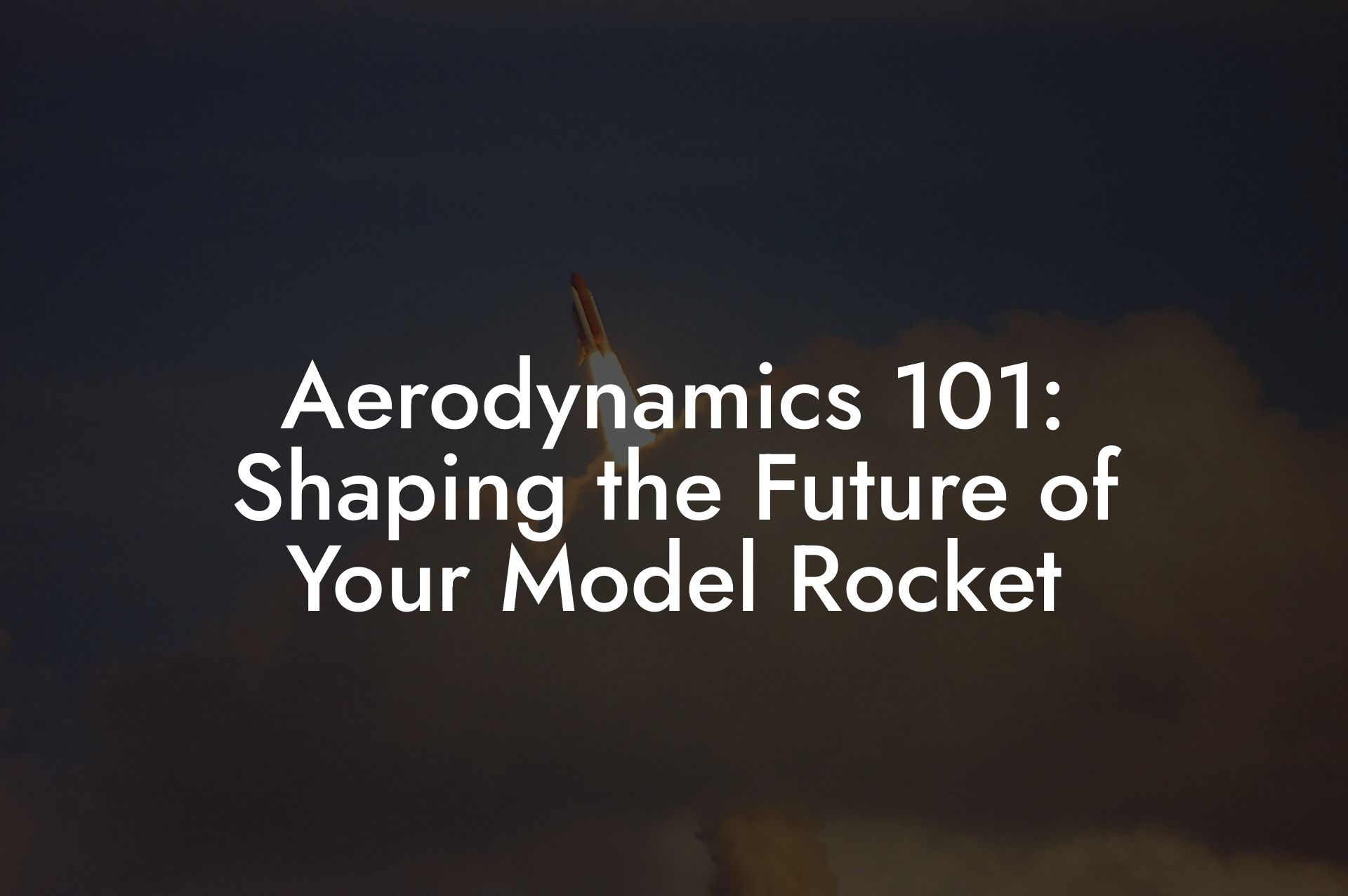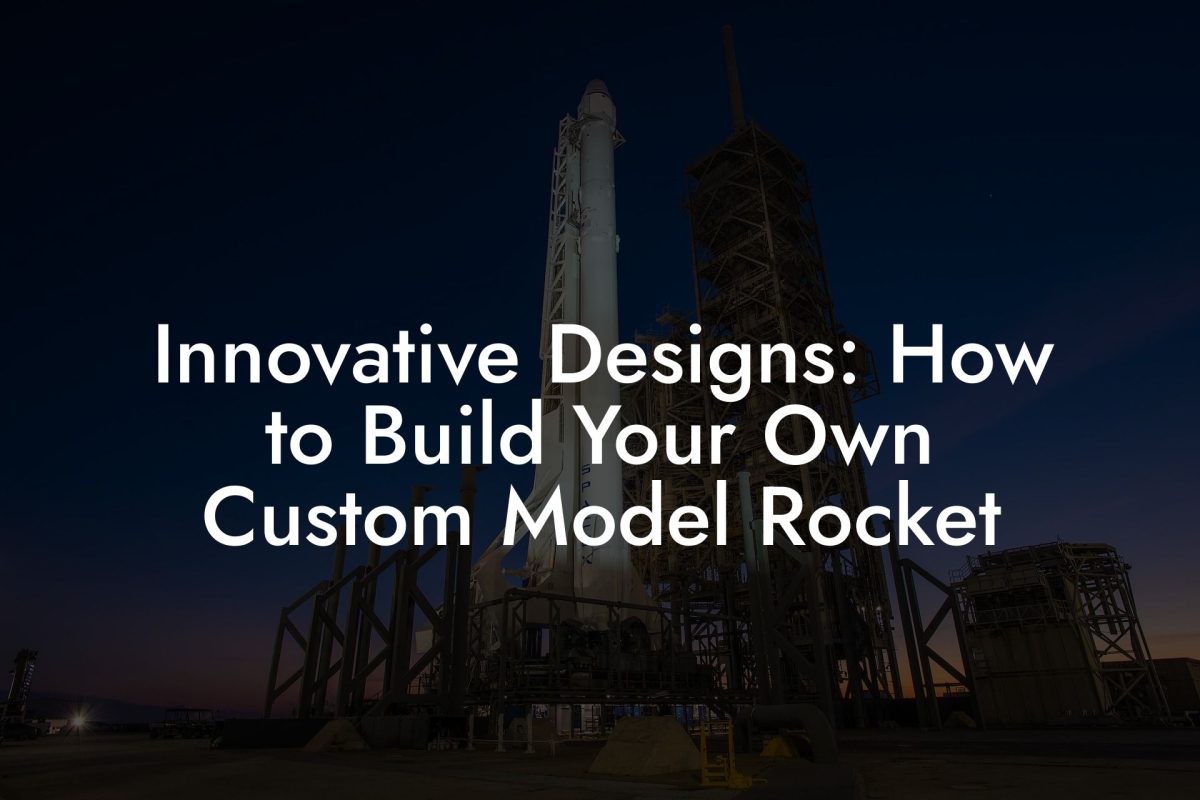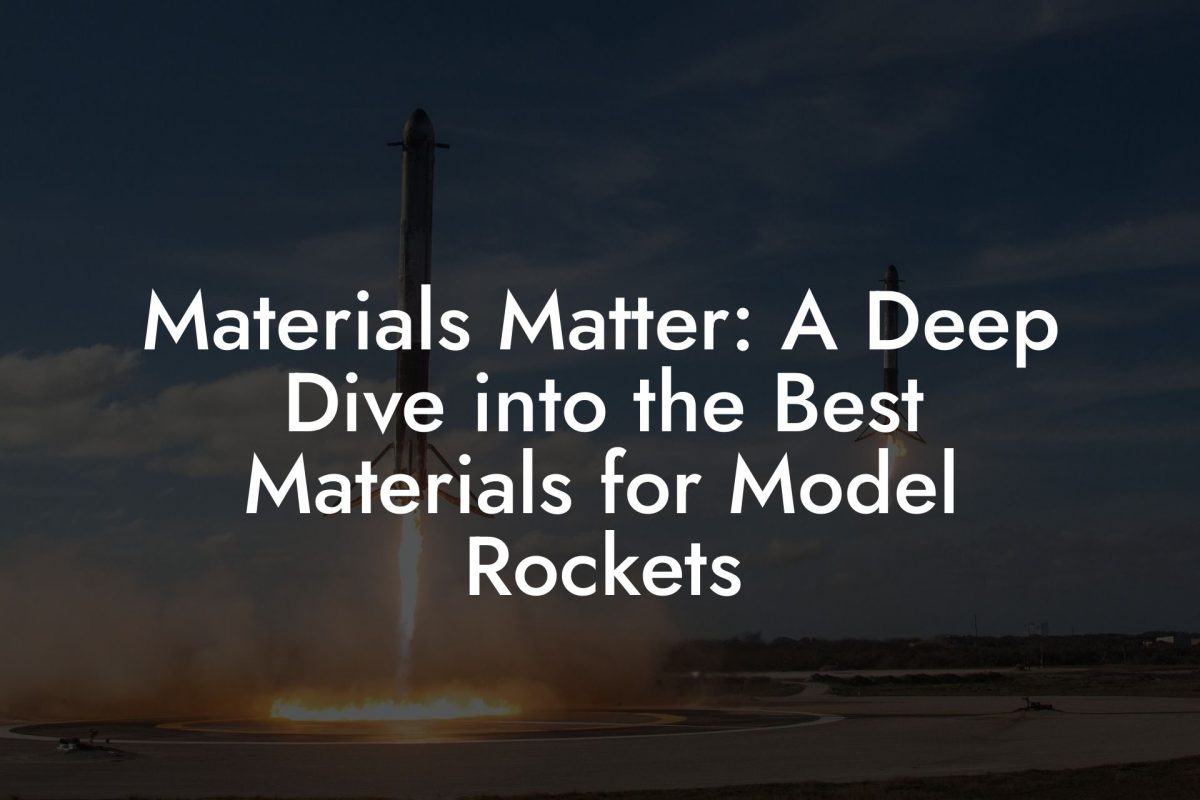Ready to transform your model rocket into an aerodynamic marvel? Welcome to "Aerodynamics 101: Shaping the Future of Your Model Rocket", a comprehensive guide that demystifies the science behind flight while equipping you with practical tips to optimize your rocket’s design. Whether you’re a curious beginner or a seasoned rocketeer, this guide will help you understand the critical principles of aerodynamics, reduce drag, and boost performance, all with a healthy dose of humor and a nod to the future of DIY aerospace.
Quick Links to Useful Sections
- Understanding Aerodynamics: The Science Behind Flight
- The Four Pillars of Rocket Aerodynamics
- Streamlining Your Rocket: Reducing Drag for Maximum Performance
- Lift and Stability: Keeping Your Rocket on Course
- Computational Fluid Dynamics (CFD): Simulating the Perfect Flight
- Practical Tips for Improving Aerodynamics in Your Design
- Advanced Aerodynamic Concepts: Beyond the Basics
- Boundary Layer Control
- Active Aerodynamic Surfaces
- Vortex Generators
- Case Studies: Learning from Successful Rocket Designs
- The Sleek High-Flyer
- The Minimalist Approach
- The Adaptive Innovator
- Model Rocket Aerodynamics FAQs: Your Burning Questions Answered
- Your Next Launch: Fly High with Optimized Aerodynamics
Understanding Aerodynamics: The Science Behind Flight
Aerodynamics is the study of how air flows around objects, and it’s the secret sauce that makes your model rocket defy gravity. At its core, aerodynamics influences lift, drag, thrust, and stability, four essential factors that determine how smoothly and efficiently your rocket flies. By understanding these principles, you can shape your design to cut through the air like a hot knife through butter.
In model rocketry, every curve, angle, and surface finish plays a role in performance. A well-designed rocket minimizes air resistance (drag) while maximizing lift and stability. The goal? A rocket that soars higher, faster, and with precision.
The Four Pillars of Rocket Aerodynamics
To truly master the art of aerodynamics, you need to grasp the interplay of four fundamental forces:
- Thrust: The force produced by your rocket’s engine that propels it upward.
- Drag: The resistance encountered as your rocket cuts through the air. Minimizing drag is crucial for achieving optimal speed and altitude.
- Lift: While more commonly associated with aircraft wings, lift in rockets helps stabilize flight during certain maneuvers.
- Weight: The gravitational force pulling your rocket downward, which must be overcome by thrust and balanced by aerodynamic forces.
Balancing these forces is like choreographing a dance in the sky, when done right, your rocket will perform a flawless routine every time.
Looking For The Best Model Rocket Kits? You'll Love These:
Streamlining Your Rocket: Reducing Drag for Maximum Performance
Drag is the nemesis of every rocket. It’s the air resistance that slows you down and can significantly reduce the altitude and speed of your launch. Fortunately, there are several strategies you can employ to reduce drag:
- Sleek Nose Cones: A well-designed nose cone minimizes air turbulence by smoothly directing airflow over the body of the rocket.
- Smooth Surfaces: Imperfections, seams, or rough textures can increase drag. Sanding and applying a smooth finish can help your rocket slice through the air more efficiently.
- Streamlined Fins: Fins should be designed not only for stability but also to minimize their interference with airflow. Aerodynamically shaped fins reduce turbulence and keep your rocket on a straight path.
- Body Shape: The overall contour of your rocket should encourage laminar (smooth) airflow. Avoid abrupt changes in diameter or unnecessary protrusions that can create drag-inducing eddies.
Think of drag reduction as tuning a sports car, you want every part of your rocket working in harmony to reduce friction and maximize speed.
Lift and Stability: Keeping Your Rocket on Course
While drag and thrust often steal the spotlight, lift and stability are just as crucial for a successful flight. Even though rockets primarily rely on thrust to overcome gravity, ensuring that your rocket remains stable during ascent is key.
Fins for Stability: The placement, size, and shape of your fins play a vital role in maintaining stability. Properly aligned fins prevent unwanted tumbling and ensure a smooth, straight flight path.
Center of Gravity (CG): The CG is the balance point of your rocket. A correctly positioned CG, in relation to the center of pressure (CP), is essential. If the CP is behind the CG, your rocket will be inherently stable. Achieving the right balance can involve adding small weights or adjusting component placement.
Understanding and controlling lift isn’t just for airplane enthusiasts, it’s a crucial aspect of model rocketry that can make the difference between a graceful arc and a wild, unpredictable flight.
Computational Fluid Dynamics (CFD): Simulating the Perfect Flight
For those who want to delve deeper into the science, computational fluid dynamics (CFD) software offers a window into how air interacts with your rocket. With CFD, you can simulate airflow over your design, identify areas of high drag or turbulence, and experiment with modifications virtually before committing to physical changes.
Tools like ANSYS Fluent or open-source alternatives such as OpenFOAM allow rocketeers to:
- Visualize airflow patterns and detect problem areas
- Test different nose cone designs and fin configurations
- Optimize material choices and surface finishes
While CFD might sound like rocket science (pun absolutely intended), even a basic simulation can provide valuable insights that lead to better design decisions and improved flight performance.
Practical Tips for Improving Aerodynamics in Your Design
Here are some actionable tips that you can implement to enhance the aerodynamic performance of your model rocket:
- Invest in Quality Finishing: Smooth, even paint jobs and carefully sealed seams go a long way toward reducing drag.
- Test and Iterate: Don’t be afraid to launch test models and tweak your design based on real-world performance. Each launch is an opportunity to learn.
- Monitor the Center of Gravity: Use digital calipers and precision scales to ensure your rocket’s weight is evenly distributed for optimum stability.
- Keep It Simple: Overly complex designs with unnecessary protrusions can create more drag than benefit. Aim for sleek, minimalist lines that favor airflow.
- Use CFD When Possible: Even basic simulations can highlight areas for improvement that might not be obvious in a physical prototype.
Remember, improving aerodynamics is a continuous process of testing, learning, and refining your design. Every small adjustment can lead to significant improvements in flight performance.
Advanced Aerodynamic Concepts: Beyond the Basics
Once you’ve mastered the fundamentals, you might be ready to explore more advanced aerodynamic principles that can take your model rocket to the next level.
Boundary Layer Control
The boundary layer is the thin layer of air that clings to the surface of your rocket. By controlling this layer through surface treatments or specialized coatings, you can reduce friction and delay the transition from laminar to turbulent flow, both of which reduce drag.
Active Aerodynamic Surfaces
Some advanced rocketeers experiment with adjustable fins or deployable surfaces that change shape during flight to optimize performance at different altitudes. While this technology is still in its infancy in model rocketry, it represents a fascinating frontier for future innovation.
Vortex Generators
Small, fin-like protrusions called vortex generators can be strategically placed on your rocket to control airflow separation and reduce drag. These devices help maintain a smooth flow over the rocket’s surface, contributing to overall stability.
Exploring these advanced concepts can be both challenging and rewarding, pushing the boundaries of what’s possible with your custom designs.
Case Studies: Learning from Successful Rocket Designs
There’s no better teacher than real-world success. Let’s look at a few case studies where aerodynamic optimization played a crucial role in achieving record-breaking launches:
The Sleek High-Flyer
One model rocketeer revamped a standard kit by completely redesigning the nose cone and fin configuration. By using a CFD simulation to identify drag hotspots, they modified the shape to reduce turbulence, resulting in a rocket that soared 30% higher than previous launches.
The Minimalist Approach
Another enthusiast opted for a minimalist design, focusing on smooth surfaces and a simplified structure. The removal of unnecessary components reduced weight and drag, culminating in a rocket that achieved unprecedented speed and stability during flight.
The Adaptive Innovator
In a more experimental project, a team integrated small, adjustable fins that could change angle mid-flight. Although still in the testing phase, early results showed promising improvements in stability during high-speed maneuvers, hinting at a future where active aerodynamic surfaces become a standard feature in custom model rocketry.
These case studies highlight that, regardless of your approach, understanding and applying aerodynamic principles can lead to impressive gains in performance.
Model Rocket Aerodynamics FAQs: Your Burning Questions Answered
Below are some frequently asked questions to help clarify common concerns about aerodynamics and how they impact your model rocket’s performance.
1. What is the most important aerodynamic factor in rocket design?
While all aerodynamic factors are important, reducing drag is often the most critical element, as it directly affects speed, altitude, and overall performance.
2. How can I improve the nose cone design of my rocket?
Experiment with different shapes using CAD software and CFD simulations. A smooth, tapered design usually reduces drag and improves airflow over the body.
3. Why is the center of gravity so important?
The center of gravity (CG) determines the stability of your rocket. A properly balanced CG ensures that the rocket flies straight and resists unwanted tumbling.
4. Can small modifications really make a difference in flight performance?
Absolutely. Even minor changes in surface finish, fin alignment, or nose cone shape can significantly reduce drag and improve overall performance.
5. How do I test aerodynamic changes without expensive equipment?
Start with small-scale tests and use online simulation tools. Record your launches, compare flight data, and iterate on your design using feedback from real-world performance.
6. What tools are available for simulating airflow over my rocket?
CFD (Computational Fluid Dynamics) software, such as OpenFOAM or ANSYS Fluent, can simulate airflow patterns. Even basic versions of these tools provide valuable insights for beginners.
7. Are there simple ways to reduce drag on a model rocket?
Yes, ensure that surfaces are smooth, edges are well-finished, and unnecessary components are minimized. Sometimes, less is more when it comes to aerodynamic efficiency.
8. How can I measure the center of pressure on my rocket?
The center of pressure (CP) can be estimated using aerodynamic formulas and simulation software. Experimenting with fin placement and design adjustments can also help you achieve the optimal CP.
9. What role do advanced materials play in aerodynamics?
Advanced materials such as carbon fiber and fiberglass provide smoother surfaces and more rigid structures, both of which contribute to reduced drag and enhanced performance.
10. How important is iterative testing in improving aerodynamics?
Iterative testing is crucial. Each test launch provides data that can be used to refine your design, making small tweaks that collectively lead to significant improvements.
Your Next Launch: Fly High with Optimized Aerodynamics
By understanding and applying aerodynamic principles, you’re setting the stage for a model rocket that not only looks sleek but also performs at its peak. Every design tweak, every simulation, and every test launch brings you closer to that perfect balance between art and science.
Embrace the journey of iterative improvement and let your passion for innovation drive you to new heights. Whether you’re refining your nose cone, tweaking your fin design, or exploring advanced materials, remember that the future of your model rocket is in your hands, and in the air.
The sky is not the limit; it’s just the beginning of your aerodynamic adventure. So gear up, run your simulations, and prepare to launch a rocket that’s engineered for excellence and destined to soar.
Looking For The Best Model Rocket Kits? You'll Love These:
Useful Interruption: Dive deeper into the world of Model Rockets with our most popular sections. If there is anything you think is missing or anything you would love for us to write about, just give us a shout.
- Getting Started & Basics With Model Rockets
- Model Rocket Design, Build & Customization
- Model Rocket Propulsion & Engine Technology
- Model Rocket Launch Techniques & Recovery
- Model Rocket Advanced Rocketry & Innovations
- Model Rocket DIY and Customization
- Model Rocket Equipment Reviews & Digital Tools
- Community, Competitions & Education
- Model Rocket Troubleshooting & FAQs
- Model Rocket Bonus/Seasonal & Niche Topics
A group of model rocket enthusiasts gathered at a field for their weekly launch event. Among them was Dave, a seasoned builder known for pushing the limits of hobby rocketry. This time, he had outdone himself.
“Ladies and gentlemen,” Dave announced, dramatically pulling a cloth off his latest creation, “I present to you: The Kraken!”
The crowd gasped. This wasn’t just a model rocket, it was a monster. The thing stood 8 feet tall, had six clustered engines, and was covered in enough duct tape to qualify as a classified aerospace project.
“Dave,” muttered Steve, the cautious safety officer, “Have you, uh… done the math on this?”
“Math?” Dave scoffed. “I built it in my garage at 3 a.m. with parts from eBay. This is an art piece, Steve.”
The countdown began.
5…
4…
3…
2…
1…
The engines ignited with a BOOM, and The Kraken shot up… kind of. It immediately did a violent barrel roll, narrowly missing the spectators before skyrocketing at an angle that could only be described as “legally questionable.”
The crowd collectively ducked as The Kraken flew straight over the adjacent cornfield, where Old Man Jenkins, the grumpiest farmer in town, was minding his business.
KABOOM!
The rocket disappeared behind the barn. A moment later, a flaming piece of Estes igniter wire landed at Steve’s feet. The silence was deafening.
And then, an unmistakable sound echoed across the field.
Jenkins’ shotgun being cocked.
“DAVE!!!” Steve shouted. “RUN.”
And that was the day Dave invented the first-ever biologically powered rocket booster: pure adrenaline.
To this day, nobody knows where The Kraken landed, but legend has it, it still haunts the skies, terrifying unsuspecting drones and low-flying birds.






